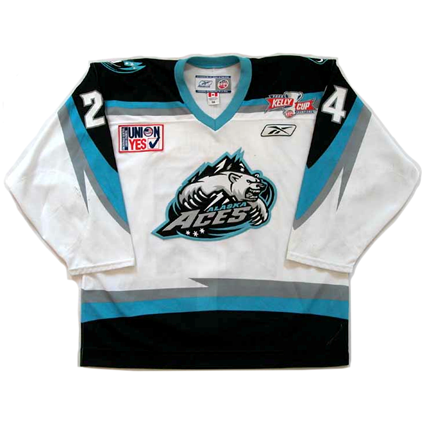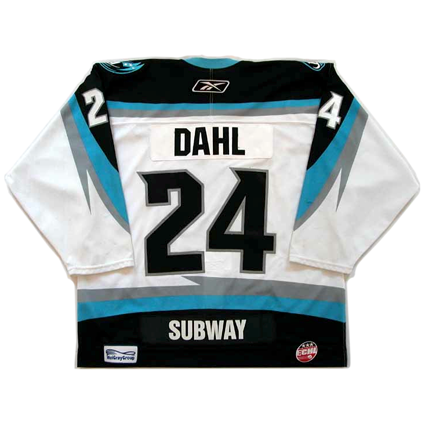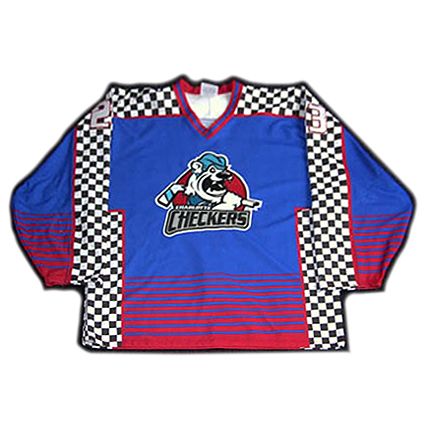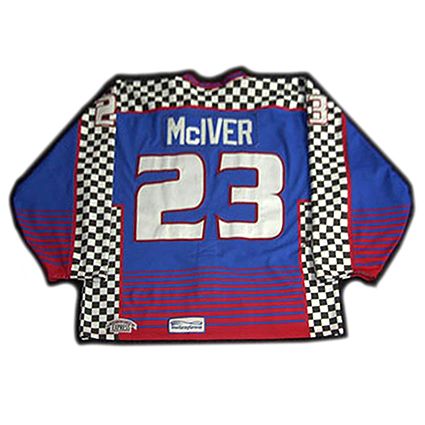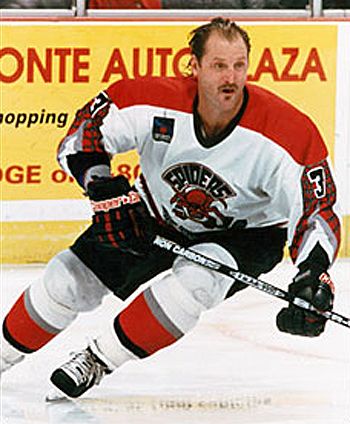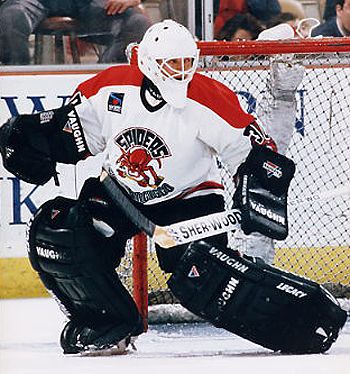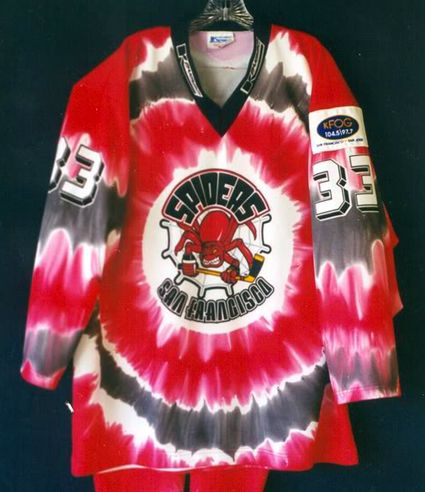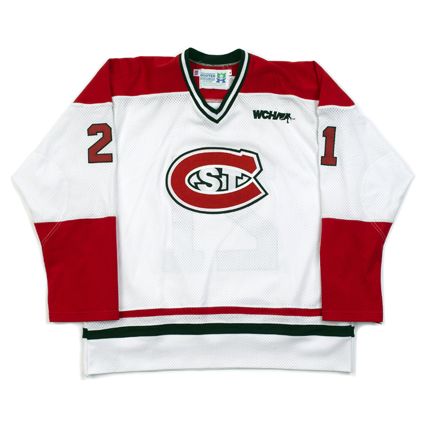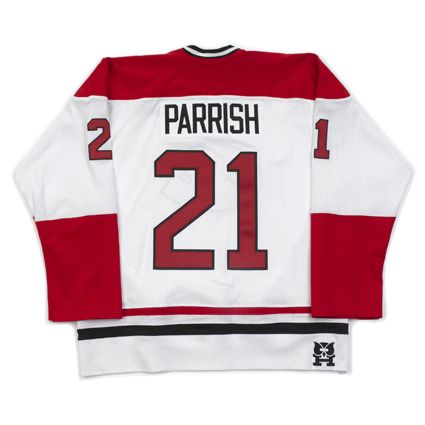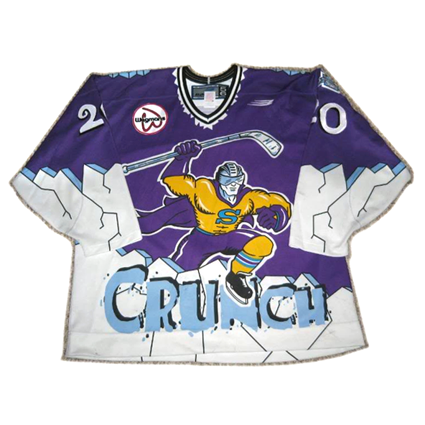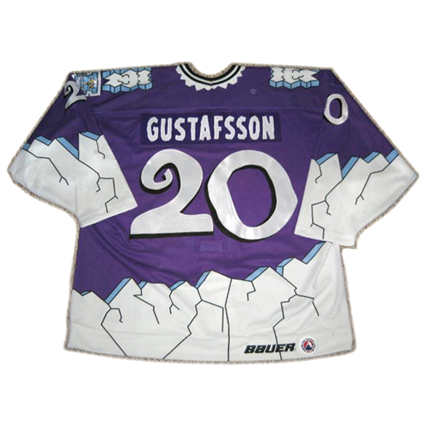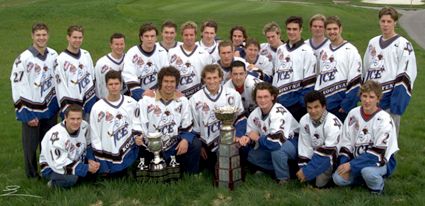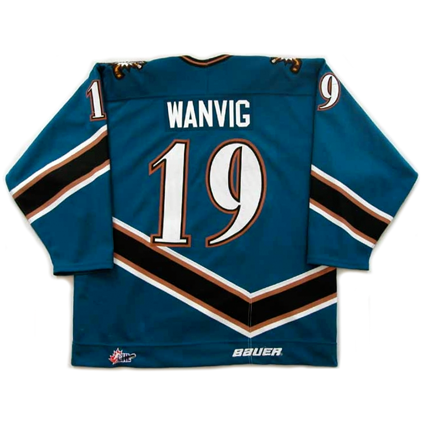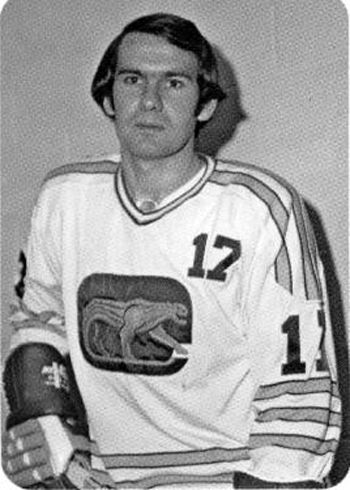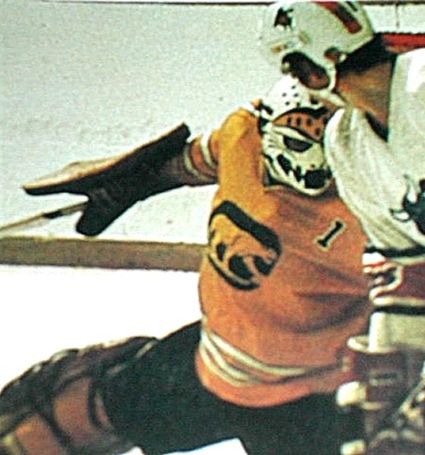Saturday, July 24, 2010
2006-07 Alaska Aces Jim Dahl Jersey
July by the Numbers racks up the frequent flyer miles as we head cross-continent to Alaska for jersey #24.
The East Coast Hockey League was formed in 1988 and is widely considered the third rung on the professional hockey ladder below the NHL and the AHL, with many of it's teams having affiliations with NHL and their AHL farm teams.
The league had humble beginnings with just five teams, it underwent a fairly blistering period of expansion, more than doubling to 11 teams in it's third season, adding four more in 1991 and gaining four more in 1993, finally quadrupling it's original size in 1995-96 with 21 clubs.
It continued to add clubs at a nearly unabated pace, netting two more in 1996, 1997 and 1998 plus one more in 1999. It lost three teams in 2000 and responded by adding four total the following season! It again contracted by two and reacted once again by adding four in 2003 when it accepted ten clubs primarily from the defunct West Coast Hockey League but lost six teams in the southeast to reach 31 clubs - six times it's original size in 16 seasons and a now vastly increased footprint across North America.
Since reaching it's high of 31 clubs, the recent economic downturn has taken it's toll on the ECHL, as it began to shed teams, losing three total in 2004, three more in 2007, two in 2008 and three more in 2009 to drop to a 15 year low.
It's also not as simple as two or three clubs folding in a given year either, as the unstable league has seen many clubs leave each season, offset by a number of new arrivals. In 2008-09 for example, five clubs left the league while two new ones joined for a net of minus three. Even in an apparent run of "stability" when the league stayed at 25 clubs for two consecutive seasons, 2005-06 saw two leave and two join and 2006-07 had another three join only to be balanced out by three who left! Since 2004, 24 clubs have left the league while 13 have joined.
Many colorful team names have been a part of the ECHL, such as the Atlantic City Boardwalk Bullies, the Greenville Grrrowl, the Lexington Men O' War, the Louisiana IceGators, the Louisville River Frogs, the Mobile Mysticks, the Pee Dee Pride and who could forget the Macon Whoopee?
Through all the franchise comings and goings, one team remained, the Johnstown Chiefs, who sadly announced in February of 2010 that they would be relocating to Greenville, South Carolina after a run of 22 seasons, a virtual lifetime in the lower minors.
While there have obviously been many franchises that have folded outright or sought greener pastures in other places through relocation, three former ECHL clubs have moved up to the AHL, seeking a greater challenge. The Hampton Roads Admirals joined he ECHL in 1989 and won three championships (1991, 1992 and 1998) before joining the AHL and changing their name to the Norfolk Admirals.
The Peoria Rivermen entered the ECHL in 1996 and played until 2005 before their owners bought the Worcester IceCats of the AHL and moved them to Peoria and renamed them the Rivermen for the 2005-06 season.
In a similar maneuver, the owner of the Charlotte Checkers purchased the Albany River Rats of the AHL and will move them to Charlotte for the 2010-11 season while maintaining the Checkers identity.
The winner of the ECHL playoffs receives the Kelly Cup and to date 15 teams have won the ECHL championship with the Hampton Roads Admirals and the South Carolina Stingrays having the most championships with three each.
The Anchorage Aces were an amateur national championship club formed in 1989 and turned professional in 1995 as a member of the WCHL. They then moved to the ECHL in 2003 with the demise of the WCHL and were then renamed the Alaska Aces, which necessitated a new logo and new uniforms. Since becoming a member of the ECHL, the Aces have made the playoffs every season and made the finals twice, losing in 2009 and winning the championship in 2006.
To date, former Aces of note who have gone on to play in the NHL are Wade Brookbank and D. J. King, both of whom have over 100 games of NHL experience on their resume. The best known former Ace is Alaska native Scott Gomez, who returned to Alaska to play for the Aces during the NHL lockout of 2004-05 and led the league in scoring on his way to being named league MVP.
Gomez signs with the Aces
Today's featured jersey is a 2006-07 Alaska Aces Jim Dahl jersey. It's a very nicely executed jersey with unique arm and waist striping that ties in with their really nice logo, especially considering some of the wild creations sometimes seen in the lower minors. While the number font is not unique to the Aces, the speed flashes on the upper left corner also relate nicely to the flashes on the waist and arm stripes making for a very cohesive package.
This jersey also sports several sponsorship patches, two on the back and one in the traditional right chest location often found in the minors, which is balanced by the braggadocios 2006 Kelly Cup Champions patch on the upper left chest which reminds the rest of the league of the Aces reign over them.
Overall a very professional effort.
In today's video segment, the Aces win the 2006 Kelly Cup. And there was much rejoicing.
Labels:
Alaska Aces,
ECHL
Friday, July 23, 2010
2002-03 Charlotte Checkers Chad McIver Jersey
July by the Numbers visits the southeast for jersey #23.
Located in the heart of NASCAR country, the Charlotte Checkers were formed in 1993 as members of the East Coast Hockey League. The ECHL ranks third on the ladder system of North American hockey leagues below the top rung of the NHL and the top minor league, the AHL.
The Checkers, a clever reference to both body checks in hockey and the checkered flag in racing, have been a bright spot in the ECHL, with the team averaging nine or ten thousand fans a game, with some crowds reaching 12,000.
Attendance has been helped by the team's success on the ice in the early years, with the team posting winning records in their first two seasons prior to winning the ECHL championship and the Kelly Cup in just their third season of existence in 1995-96. Two more winning seasons followed, giving the club five consecutive years of playoff appearances from their inception.
Even their first season below .500 was just barely so with a record of 29-30-11. The club qualified for the playoffs in the next two seasons before perhaps setting a record for the best team to miss the playoffs in any hockey league anywhere, when the Checkers posted a 41-20-3 mark, a .665 wining percentage, yet failed to make the ECHL playoffs despite having more points in the standings than six other teams and 21 points more than the Greenville Grrrowl, who did qualify!
After one more season out of the playoffs, the Checkers ran off a string of six consecutive postseason appearances, including the 2009-10 season when they tied a club record set during their championship season of 1995-96 with 94 points in the standings.
The 2009-10 season was the last for the Checkers in the ECHL, as the team owner relinquished their ECHL membership after purchasing the Albany River Rats of the AHL and relocating that franchise to Charlotte where they will adopt the Checkers identity, moving the Charlotte market up one level of play from the ECHL to the AHL. The only alteration will be to the team's colors, changing from light blue, navy blue and black to red, black and silver to reflect the team's new affiliation with the Carolina Hurricanes of the NHL, located just 150 miles up the road.
Darryl Noren was the all-time leading scorer for the Checkers during the ECHL era. Noren skated for Charlotte from 1994 to 2000, scoring 174 goals and 229 assists for 403 points in six seasons to lead the franchise in all three categories. Defenseman Kurt Seher was the longest serving Checker, having played 10 seasons in Charlotte, four more than anyone else.
Notable players to have played for the Checkers include Eric Boulton, Eric Cairns, Antti Laaksonen, Jason LaBarbera and Peter Worrell.
Today's featured jersey is a 2002-03 Charlotte Checkers Norm McIver jersey. During their early years the Checkers were known for their frankly horrific jerseys, which all seem to have been designed by someone unfamiliar with ice hockey and for some reason reminds us more of the kind of interior decorating you'd find in a breakfast cafe along the interstate while on vacation in North Dakota.
Despite their checkered past, Charlotte's jersey situation has been on the upswing as of late, thanks in no small part to an excellent new logo which was introduced in 2007 after a change in ownership, replacing the amateurish, cartoony logos of the past.
Still, you cannot erase the past, and Charlotte has some real skeletons in their jersey closet, not the least of which are their jerseys from the early 2000's, a checkered flag trimmed jersey with the body and sleeves adorned with "speed stripes", parallel stripes of decreasing width separated by contrasting color stripes of increasing width. The overall effect, when combined with the cartoonish logo, was a loud assault on the eyes better suited to mid-90's roller hockey.
In our video section today, Charlotte shows it's connection with the citizens of Charlotte, the kind of connection only possible in the minors.
Here's another funny ad campaign from the Checkers.
They did it, and did it rather well, but we can't really figure out why they did it. The Checkers mascot, by the way, is the brilliantly named "Chubby Checker".
Labels:
Charlotte Checkers,
ECHL
Thursday, July 22, 2010
1995-96 San Francisco Spiders Normand Rochefort Jersey
July by the Numbers visits the city by the bay for jersey #22.
The San Francisco Spiders were granted an expansion franchise in the International Hockey League for the 1995-96 season in November of 1994 and announced their team name and logo in December.
Their home rink was the famed Cow Palace and their first game was a 5-1 loss to the Los Angeles Ice Dogs in front of 11,415 fans on September 29, 1995 with the first goal in team history being scored by Sandis Ozolinsh, who played a pair of games for the Spiders while holding out from the NHL's San Jose Sharks prior to being traded to the Colorado Avalanche.
Also of note to play for the Spiders was future Hall of Famer Rod Langway. Following his retirement from the NHL in 1993, Langway hit the ice once again as a player/coach for the Spiders, seeing action in 46 games in 1995-96.
Rod Langway
Eight former members of the Sharks, who began life also calling the Cow Palace home in 1991-92, skated for the Spiders that season.
The club finished with a respectable winning record of 40-32-10, good for third place in the South division and a spot in the IHL's Turner Cup playoffs. Goaltender Stephane Beauregard was named the winner of the James Gatschene Memorial Trophy as the league's MVP following his 36-24-8 record with a 3.09 goals against average. John Purves was by far and away the team's leading scorer, with 56 goals and 49 assists for 105 points, 45 more than the next highest Spider. Purves placed second in the league goal scoring race and seventh in points. Despite than success, Purves would finish his career with a total of seven NHL games, all of which came prior to his season with San Francisco.
Stephane Beauregard
Game 1 against the Chicago Wolves went to the Spiders at home 4-2, but Chicago defeated San Francisco 4-1 and then swept them back at home in Chicago 3-1 and 2-1 in overtime to eliminate the Spiders from the playoffs in what would turn out to be the final Spiders game ever.
Difficulties with the aging arena and poor attendance plagued the club. Weekend attendance was around the 7,500 mark, but weekday games ruined the average attendance as the club struggled to draw over 2,500. Citing losses of over $6 million, the team filed for bankruptcy protection and ceased operations on June 24, 1996 after but one season on the ice, becoming a footnote in the history of minor league hockey.
Today's featured jersey is a 1995-96 San Francisco Spiders Normand Rochefort jersey. For the Spiders one and only season, every day was Halloween with these unusual jerseys donned by the Spiders, especially when compared to the current state of the art in the NHL at the time when these were designed.
The spider web pattern contained in the red striping was a very simple but highly effective addition which created a jersey that looked much busier than it really was.
Their logo added to the overall feeling of this being a complex jersey as the spider itself was rather detailed and the radical font chosen for the team and city name created a near vortex of lines due to the length of both names.
The radical nature of the jersey continued on the back and sleeves with the addition of the numbers done in the same font as the "Spiders" wordmark from the main crest. While the sleeve numbers are somewhat difficult to read based on their shape and location at one the busiest spot on the jersey, the back numbers are surprisingly bold and legible. The simple block font for the names are unexpectedly simple and one can only imagine what suggestions for fonts the designer may have proposed that were passed over! A vertically arched block font like that used by the Detroit Red Wings, which would have followed the curvature of the top of the back numbers surely must have been considered at some point.
These jerseys unusual look, which was quite radical for the time, and their limited availability due to the incredibly brief short period of use have made these a favorite among the collecting hobby and very sought after.
Bonus jersey: Today's bonus jersey is a 1995-96 San Francisco Spiders tie dye jersey. If the standard Spiders jersey wasn't busy enough as it was, this special tie dyed jersey takes the vortex effect of the main logo to a whole new level!
And why the different font for the numbers? Surely it wasn't an effort to make the jersey "less busy" was it? The numbers certainly are an odd choice, as the treatment they received give them an almost metallic appearance, totally not keeping with the look and feel of the jersey or the team's identity. Perhaps they had something to do with radio station KFOG's visual identity, the sponsor of the game in which they jerseys were worn, and not that of the team.
Labels:
IHL,
San Francisco Spiders
Wednesday, July 21, 2010
1996-97 St. Cloud State Huskies Mark Parrish Jersey
July by the Numbers stops in the midwest for jersey #21.
The conference that would become known as the WCHA was founded in 1951 and underwent a few name changes prior to becoming the Western Collegiate Hockey Association in 1959.
Of the original seven members, Colorado College, Denver, North Dakota, Minnesota and Michigan Tech still remain, although Michigan Tech briefly departed, taking the MacNaughton Cup with them, for three seasons in the early 1980's before returning in 1984.
The league began to expand in 1965 when Minnesota-Duluth was added to the league and Wisconsin followed in 1969. Notre Dame became the tenth member in 1971 and the league remained stable until a dramatic defection in 1981 when founding members Michigan, Michigan State and Michigan Tech plus Notre Dame all departed en masse for the CCHA, leaving the league with just six clubs.
Michigan Tech returned in 1984, as well as the MacNaughton Cup, as it is awarded to the league champion of whichever league Michigan Tech is a member of, and brought Northern Michigan with them, expanding the league to eight teams once more.
Six years later St. Cloud State gained acceptance to the league prior to the league taking in Alaska Anchorage in 1993 to once more reach ten members for the first time since 1980.
1997 saw Northern Michigan return to the CCHA but two seasons later Minnesota State entered the league which began a period of stability, as membership remained the same through the end of 2009-10.
Next season the league will reach an all time high with 12 teams as both Bemidji State and Nebraska-Omaha begin play in the nation's college hockey powerhouse.
To date, 35 national championships have been won by WCHA schools, with the first being the inaugural championship in 1948 by then member Michigan. Colorado College followed in 1950 prior to Michigan reeling off three in a row. After a one year break, WCHA schools reeled off 12 in a row from 1955 to 1966. Michigan (3 championships), Colorado College, Denver (3), North Dakota (2), Michigan Tech (2) and Michigan State all contributed to the league's greatest era of dominance.
Denver won back to back in 1968 and 1969. Wisconsin won their first in 1973 to start a run of ten out of 11 for the conference, with Wisconsin (4) Minnesota (3), Michigan Tech and North Dakota (2) all taking turns.
North Dakota won in 1987 and Wisconsin opened the 1990's with the league's 27th prior to Northern Michigan's first in 1991. The league would wait until 1997 for North Dakota to add another to the ledger and they brought home the WCHA's 30th in 2000.
Beginning in 2002, the league captured five consecutive when Minnesota went back to back in 2002 and 2003, which was matched by Denver in 2004 and 2005, notable as all four participants in the Frozen Four were from the WCHA when Denver, North Dakota, Minnesota and Colorado College all won their regional tournaments that season, before Wisconsin won in 2006 to bring the league up to 35.
The St. Cloud State Huskies program can be traced back to 1932 when the school was known as the St. Cloud Teachers College. The school was renamed St. Cloud State in 1942 and eventually joined the NAIA at the Division II level.
The move up to Division I began in 1986 with the hiring of 1980 Olympic gold medal winning coach Herb Brooks. The team went 17-4-1 and broke or tied 45 school records that season on their way to the NCHA championship. Following the season plans were approved to build the team's new home, the National Hockey Center, which hosted it's first game in December of 1989.
1987-88 saw Brooks depart for the NHL and the team embark on it's first Division I season, making the NCAA playoffs the following season. 1990 saw the Huskies welcomed into the WCHA and they one their first WCHA playoff championship in 2000-01.
St. Cloud State Huskies - 2001 WCHA Playoff Champions
After seven previous bids, St. Cloud won their first NCAA tournament game in 2010 with a 4-3 win over Northern Michigan in double overtime.
With the upgrade in status, the team also began to regularly send it's players on to the NHL. Familiar names to have skated for St. Cloud who have gone on to play in the NHL include Bret Hedican, Matt Cullen, Mark Parrish, Tyler Arnason, Mark Hartigan, Jeff Finger and Ryan Malone.
Today's featured jersey is a 1996-97 St. Cloud State Huskies Mark Parrish jersey. While we recently trashed the Kootenay Ice for slapping their horrid logo on the jersey of the Washington Capitals, the St. Cloud State Huskies have taken a similar approach, but with infinitely more successful results.
Their home white jersey is a virtual copy of the classic Montreal Canadiens jersey, only this time with a clever take on the Canadiens iconic "CH" logo by swapping out the "H" for an "ST". This gives the Huskies an instantly familiar appearing logo that says "hockey" at first glance, but rewards the viewer on closer inspection. Additionally, while the jersey pattern is the same, the Huskies employ red, black and white as team colors, allowing them to avoid the criticism of simply copying the NHL club's jersey stitch for stitch.
Additionally, unlike Kootenay, who copied both Washington's home and road jerseys outright, St. Cloud took a different approach to their road jersey, going in an entirely different direction than Montreal's iconic red jersey with it's blue chest stripe, and created a menacing all black jersey, but still in a simple, classic style.
The lesson here is if you are going to base your jersey on an existing jersey, it's better to start with a timeless classic and add some well thought out tweaks to make it your own, rather than simply copy a faddish jersey template with trendy colors and slap on a poor, amateurish logo.
Today's video segment begins with St. Cloud State's first NCAA tournament victory in team history in March of 2010 in double overtime after seven previous appearances, all of which ended in defeat.
With St. Cloud down by a goal, here is a dramatic goal by the Huskies Ben Hanowski when he scored as time expired. Or did he?
Finally, a look at the National Hockey Center, home of the St. Cloud State Huskies.
Labels:
St. Cloud State,
WCHA
Tuesday, July 20, 2010
1998-99 Syracuse Crunch Marcus Gustafsson Jersey
July by the Numbers once more remains in New York State, traveling 70 miles up Interstate 81 for jersey #20.
The Syracuse Crunch began life as the Hamilton Canucks in 1992 and relocated to Syracuse, New York in 1994, with their new name the "Syracuse Crunch" selected from a choice of five names in a public vote. We'd certainly be curious to know what the other four choices were given the selection of Crunch as the winner...
Since their arrival in Syracuse, the Crunch have frankly not had the greatest success in the standings, having won a division title once in 2001-02, but they have topped 100 points twice, with 100 in 2007-08 and a team record 102 in 2005-06.
In the playoffs, the Crunch have yet to make it to the Calder Cup Finals with their best result being an appearance in the third round in 1995-96 after defeating New York rivals the Binghamton Whalers 3-1 and the Baltimore Bandits 4-1 before falling to the eventual champion Rochester Americans in five games.
In 2002 and 2008 Syracuse advanced to the second round of the playoffs but otherwise have six first round playoff exits on their resume and seven seasons of missing the playoffs.
Notable players to have skated for Syracuse consist of Adrian Aucoin, Bates Battaglia, Darby Hendrickson, Trent Klatt, Michael Rosival, Dave Scatchard and Brent Sopel, who have all played more than 500 games in the NHL.
Today's featured jersey is a 1998-99 Syracuse Crunch Marcus Gustafsson jersey. Many times minor league clubs have the desire to go out on a limb and create a crazy, unorthodox jersey to garner some attention for their small club toiling in the depths of the minor leagues without the fear of risking the massive income at stake at the NHL level if they get it wrong.
One such jersey is the Syracuse Crunch's wild purple alternate jersey used in the 1998-99 season. The Crunch already had an unconventional logo, but then put "Crunchman" in action on their alternate jersey, as he is now leaping out of the jersey with stick in hand, as the ice around him shatters through the miracle of dye-sublimation.
The jersey is finished off with one of the most bizarre and unusual choice of fonts for the name and particularly the numbers ever in any league, anywhere at any time. Images of the Flintstones immediately came to our minds.
If not busy enough, the jersey also features a sponsorship patch on the right chest and a Crunch 5th Anniversary patch on the left arm/shoulder!
These jerseys are often regulars on strangest jerseys lists that extend beyond the NHL, and once you've seen one, you won't soon forget it. While not many casual fans are even aware of these jerseys, their bizarre looks and very limited availability have made them very sought after among game worn jersey collectors.
Labels:
AHL,
Syracuse Crunch
Monday, July 19, 2010
1998-99 Kootenay Ice Kyle Wanvig Jersey
July by the Numbers travels to western Canada for Jersey #19.
The Western Hockey League was founded in 1966 and consisted of seven teams in Saskatchewan and Alberta. Currently, membership has grown to 22 clubs in not only Saskatchewan and Alberta, but also Manitoba and British Columbia in Canada and teams in Washington and Oregon in the United States.
The league began to grow and expand, attracting more and more clubs and sending players such as Bobby Clarke and Reggie Leach to the NHL only helped it's credibility. It eventually expanded all the way west to Vancouver and then even south into the United States. The "outlaw" league was then recognized by the Canadian Amateur Hockey Association and allowed to compete for the Memorial Cup, the national junior hockey championship decided annually between the champions of the WHL, Ontario Hockey League and Quebec Major Junior Hockey League plus the tournament's host club, beginning in 1970.
The first WHL team to win the Memorial Cup was the Regina Pats in 1974, followed by New Westminster Bruins back to back in 1977 and 1978. Five more championships followed in the 1980's before the Kamloops Blazers took three between 1992 and 1995. Portland added their second in 1998 to give the WHL a total of four in the 1990's. Another five in the 2000's brought the league total to 18 in the 40 years they've been eligible.
The Kootenay Ice were originally formed in 1996 as the Edmonton Ice and the franchise relocated to Cranbrook, British Columbia two seasons later.
In only their second season in Cranbrook, the club finished with the second best regular season in the WHL and swept Red Deer in four, downed Swift Current in six before defeating Calgary in five to advance to the WHL championship where they were to meet Spokane.
After dropping the first two games at home, Kootenay was given little hope by many, but they responded by taking the next to on the road in Spokane to even the series at 2-2. With momentum on their side, the Ice won game five at home and clinched the title with a 1-0 win back in Spokane.
Two seasons later in 2001-02, Kootenay again made the WHL playoffs, and followed a familiar pattern, losing their first two first round games at home to the Prince George Cougars. They again rebounded, this time winning three consecutive games in Prince George, outscoring them 15-5 in the three games. The Cougars forced a Game 7 but Kootenay advanced with a 5-1 win in the deciding game.
The Ice then went on a run, winning four straight over Seattle and four of five over Kelowna to return to the WHL championship finals. There, they prevailed in a close, hard-fought struggle against Red Deer, with Game 1 going to Kootenay on the road in overtime. Game 2 went in favor of Red Deer 2-1. Kootenay took Game 3 in overtime 3-2 only to lose Game 4 by the same score to tie the series at 2-2. A 4- 3 win for the Ice back in Red Deer put Kootenay in position to win the title with one more victory, which they managed to accomplish with a 3-2 win in double overtime of Game 6. Each of the six games were decided by a single goal, with three of the six games going to overtime.
Kootenay then advanced to the Memorial Cup playoffs thanks to their WHL playoff championship. In a tight battle, Kootenay advanced directly to the Memorial Cup Final after defeating Erie 3-0 and Guelph 4-3 before Victoriaville knocked them off 3-2 in the round robin portion.
Kootenay then captured their only Memorial Cup championship with a 6-3 win over Victoriaville in the final game.
The 2002 Kootenay Ice pose with their Memorial Cup
Since then, the Ice have qualified for the playoffs in each of the next eight seasons, but have yet to capture another WHL title despite setting and tying a team record with 104 regular season points in both 2004-05 and 2006-07.
Notable NHL players to come from the Ice include Mike Comrie, Mike Green, Marek Svatos and Matt Walker.
Today's featured jersey is a 1998-99 Kootenay Ice Kyle Wanvig jersey. While many minor league affiliates adopt the same style jerseys of their parent clubs due to the business relationship they share, that reasoning does not apply to Canadian junior teams.
This Kootenay Ice jersey is taken straight from the Washington Capitals 1995-2000 road jerseys with no alteration to the coloring, striping or font used for the numbers whatsoever. Even the secondary logos on the shoulders copies the Capitals crossed hockey sticks behind the logo.
We already have an issue with unimaginative team names such as "Ice" or "Blades" and the like, but to combine a poor choice of name with an amateurish, cartoonish logo like the Ice have chosen, and then to put it on what is essentially someone else's jersey without even bothering to select team colors of your own, shows an incredible, even inexcusable lack of thought, creativity or originality motivated by either laziness or perhaps a severely limited budget, as using an already existing supply of jerseys and having the owner's sixth grader draw (notice we did not say "design") your logo in order to save as much money as possible seems to be the only rationale for these jerseys we can come up with.
Designing a jersey for a hockey team is a rare and wonderful opportunity that many designers would love a chance to do, and there's enough talented hockey fans out there who love to post their concepts of what they would create given the chance, such as with the Manitoba Moose, whose logo was designed by a submission contest on a sports message board, that to settle for a stock jersey out of the warehouse combined with a terrible logo to identify your completely unimaginative team name is a terrible waste of an opportunity to create something memorable and worthwhile to represent your organization. We seriously wonder why no one at Bauer didn't attempt to steer the team in another direction as far as an original striping pattern or at least creating this jersey template in colors unique to the club in order to avoid having their brand name on such a shoddy effort.
Without knowing in advance, we discovered while researching this article that an authority of no less than The Hockey News agrees with us, having ranked the Ice's logo #21 out of 22 and the jersey dead last in the WHL. Clearly we could not agree more.
Speaking of horrible looking pieces of crap, their logo actually looks better when compared to their mascot, who has all the personality of an old sponge. Aren't mascots supposed to be fun and animated?
Labels:
Kootenay Ice,
WHL
Sunday, July 18, 2010
1974-75 Chicago Cougars Byron Baltimore Jersey
July by the Numbers visits the Windy City for jersey #18.
One of the founding member clubs of the World Hockey Association, the Chicago Cougars had a tremendous challenge ahead of them as they took on the established Chicago Black Hawks of the NHL on their own turf.
Unlike other WHA clubs who took on NHL teams by playing as tenants in the NHL's home arenas, such as the New York Raiders and Toronto Toros, the Cougars made the ancient International Amphitheater, built in 1934, their "temporary" home, with the hopes of relocating to the Rosemont Horizon when it was completed.
The Cougars opening game was a memorable affair, as the club hosted former Black Hawks standout Bobby Hull and the Winnipeg Jets, who Chicago defeated by a score of 3-1. The remainder of the season proved to be tough going, as the club finished dead last in the WHA with a 26-50-2 record and just 54 points in the standings, 14 behind the Raiders. The team was led in scoring by Bob Sicinski with 88 points and Rosarie Paiement's team leading 33 goals.
Bob Sicinski
With changes obviously needed, veteran leadership was provided by long time Montreal Canadien Ralph Backstrom who was lured away from the Black Hawks along with Pat Stapleton. Backstrom led the Cougars offensively with 33 goals, 50 assists and 83 points and Paiement also reached 30 goals once again while Stapleton had 52 assists from the blueline to lead the team in that category.
The signing of Ralph Backstrom
While the club improved in the standings to 81 points, it was only good for fourth in the Eastern Division, one point ahead of the Quebec Nordiques for the final playoff spot. Once in the playoffs, the Cougars upset the top seeded and defending champions the New England Whalers in seven games, including the final game on the road in Boston.
In one of the typically odd stories surrounding the WHA, the Cougars were unable to play their second round home playoff games against the Toronto Toros in the International Amphitheater due to a traveling production of "Peter Pan" with former Olympic gymnast Cathy Rigby in the title role having been booked into the arena.
An unsuccessful attempt was made to move the games to Chicago Stadium, home of the Black Hawks and the team settled on the undignified solution of playing it's games at a suburban shopping center in Randhurst, where they was a public skating rink called the Randhurst Twin Ice Arena which could hold only 2000 spectators!
The Cougars managed survive this indignity to win two of their three games in Randhurst and play well enough on the road to force a Game 7, which they won on the road to make a surprising appearance in the Avco Cup Finals.
With the Peter Pan show having concluded, the team expected to return to their home rink for the finals, only to find out they arena staff had melted the ice surface and the pipes used to chill the ice were being dismantled for the offseason! Apparently the arena and it's staff were not fans of the team and hadn't been following the Cougars progress against the Toros...
Forced to return to Randhurst, they were swept by Gordie Howe and the Houston Aeros in four straight where the Aeros took the title in the tiny arena next to the shopping mall. The bad publicity from the arena situation caused a sportswriter to come up with one of the all-time classic quotes, "The Cougars were beaten by the greatest lightweight of them all - Peter Pan."
Rookie Gary MacGregor led the 1974-75 Cougars with 42 goals and 76 points, two ahead of Paiement's 74. Dave Dryden came over from the NHL to tend goal. Things were not going well at the box office though, and the team was facing a major financial crisis which threatened to put the team out of business during the 1974-75 season, but the team's three major players, Backstrom, Stapleton and Dryden, purchased the team to keep it going through the end of the season in which the Cougars dropped to 12th place overall out of the 14 teams and failed to qualify for the playoffs.
Dave Dryden
Unfortunately, the reality of the financial situation set in and the club folded following the season, ending their challenge to the superiority of the NHL's Black Hawks, as did every other WHA team who took on an NHL club in the same city, a scene repeated in Boston, Philadelphia, New York, Los Angeles, Minnesota, Toronto, Vancouver and Detroit, giving the NHL a perfect 9-0 record and causing the WHA to retreat to outposts such as Cincinnati, Birmingham, Indianapolis, Phoenix, Calgary and San Diego.
Incidentally, construction of the Rosemont Horizon would not begin until 1977, two years after the demise of the Cougars. It was eventually be completed in 1980 - after the WHA itself had ceased to exist - and has been home to the Chicago Wolves of the AHL since 1994.
Today's featured jersey is a 1974-75 Chicago Cougars Byron Baltimore jersey as worn during the club's final season. It features the Cougars prowling cat logo contained in a rink shaped "C", somewhat reminiscent of the Vancouver Canucks original "stick in rink" logo
The Cougars attractive green and gold jerseys would remain unchanged through their three years of existence.
Our video section today features the 1973-74 Chicago Cougars in three parts in that classic 1970's style, which of course includes the soundtrack. Lots and lots of game action footage in this treasure trove of WHA video.
Don't miss the use of early rollerblades, or "street skates" in part two!
Labels:
Chicago Cougars,
WHA
Subscribe to:
Comments (Atom)


